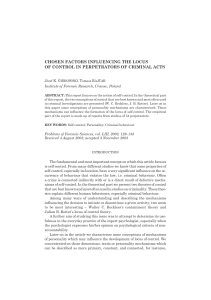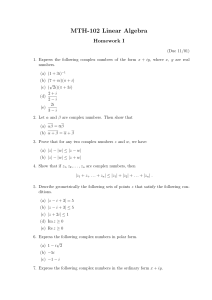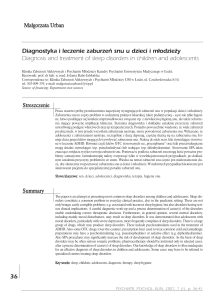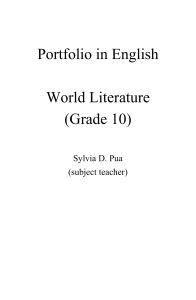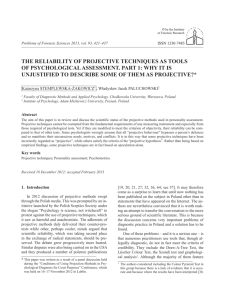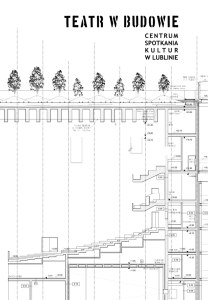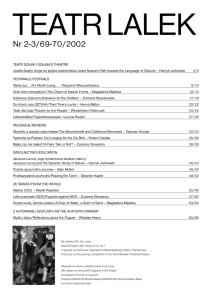PRISON SUBCULTURE AS A SET OF CONDITIONS LIMITING THE
advertisement
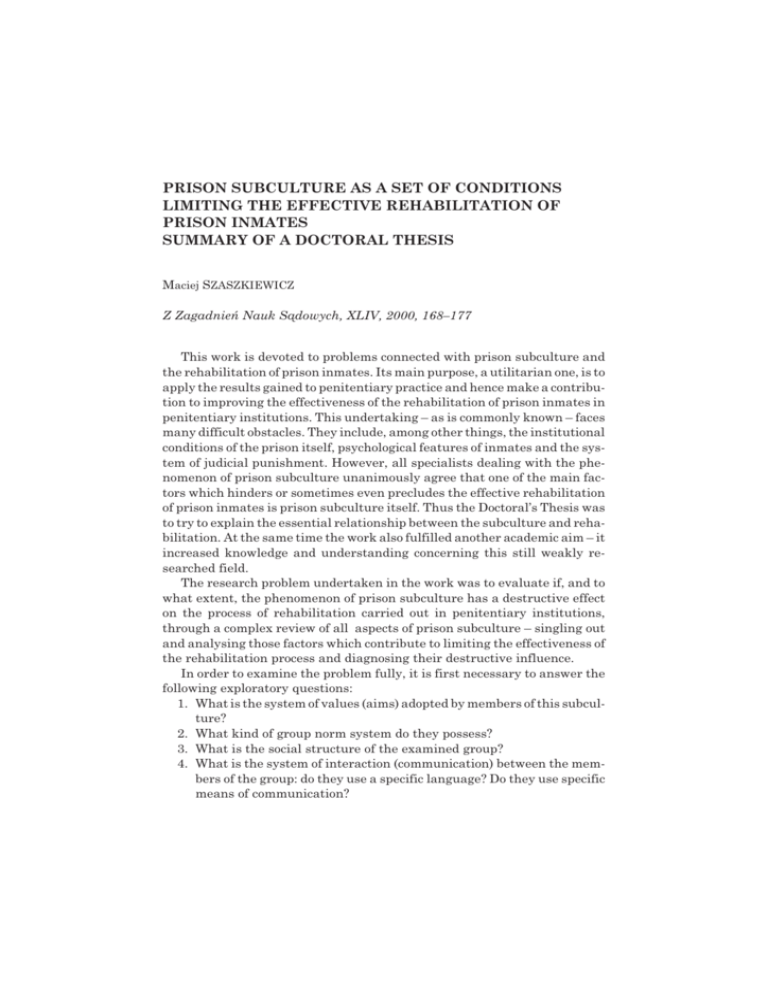
PRISON SUBCULTURE AS A SET OF CONDITIONS LIMITING THE EFFECTIVE REHABILITATION OF PRISON INMATES SUMMARY OF A DOCTORAL THESIS Maciej SZASZKIEWICZ Z Zagadnieñ Nauk S¹dowych, XLIV, 2000, 168–177 This work is devoted to problems connected with prison subculture and the rehabilitation of prison inmates. Its main purpose, a utilitarian one, is to apply the results gained to penitentiary practice and hence make a contribution to improving the effectiveness of the rehabilitation of prison inmates in penitentiary institutions. This undertaking – as is commonly known – faces many difficult obstacles. They include, among other things, the institutional conditions of the prison itself, psychological features of inmates and the system of judicial punishment. However, all specialists dealing with the phenomenon of prison subculture unanimously agree that one of the main factors which hinders or sometimes even precludes the effective rehabilitation of prison inmates is prison subculture itself. Thus the Doctoral’s Thesis was to try to explain the essential relationship between the subculture and rehabilitation. At the same time the work also fulfilled another academic aim – it increased knowledge and understanding concerning this still weakly researched field. The research problem undertaken in the work was to evaluate if, and to what extent, the phenomenon of prison subculture has a destructive effect on the process of rehabilitation carried out in penitentiary institutions, through a complex review of all aspects of prison subculture – singling out and analysing those factors which contribute to limiting the effectiveness of the rehabilitation process and diagnosing their destructive influence. In order to examine the problem fully, it is first necessary to answer the following exploratory questions: 1. What is the system of values (aims) adopted by members of this subculture? 2. What kind of group norm system do they possess? 3. What is the social structure of the examined group? 4. What is the system of interaction (communication) between the members of the group: do they use a specific language? Do they use specific means of communication? Prison subculture as a set of conditions limiting ... 169 Once these questions had been answered and hence an overview of prison subculture had been gained, the following main questions (fundamental aims of this work) could be tackled: 1. Is prison subculture a phenomenon that has a demoralising influence (leading to criminal behaviour) on its members? 2. Which specific aspects of prison subculture significantly restrict the effective rehabilitation of prisoners? 3. What is the qualitative influence of particular aspects of prison subculture on the process of rehabilitation of prison inmates? When analysing as complex a phenomenon as prison subculture one should take into consideration its unique feature – secrecy – and, furthermore, the fact that its main goal is the fight against law. One of the most important norms of the grypserka (prison underworld) code forbids, under threat of the harshest sanctions, sprzedawanie grypserki (literally “selling the underworld”), i.e. informing someone from outside the organisation about the principles of its functioning. After taking the above-mentioned factors into consideration, the following general methodological assumption was accepted: methods and research techniques aiming to penetrate the phenomenon of prison subculture in an open and direct manner would not yield expected results. Instead of such an approach, one should use methods and techniques aiming at obtaining the appropriate data in an indirect and camouflaged manner. Various methodological tools were applied to carry out the research (among other things: the analysis of documents and materials, observation of prisoners, interviews with various members of the prison community, controlled conversation). It is worth saying a few words about the conversations with the prisoners. Within the framework of this research, conversations were held with prisoners on free topics (loose conversation) or planned topics (so-called guided conversation), during which bits of information that came up concerning prison subculture were recorded. What is helpful in this method is the fact that prisoners – who use slang amongst themselves – often unconsciously use elements of it (phrases, idioms, descriptive terms, individual words) while talking to other people. So a paradoxical situation arises; a prisoner may use an expressions such as: od jareckich obskoczy³em rakietê (literally “I have dodged a rocket from the Jareckis”), which means “I have received a parcel from my parents”, when talking with outsiders, but if he is directly asked how to say “parents”, “parcel” or “receive” in grypserka slang he will not answer or say that it is a secret. Direct questions raise suspicion. Within the framework of the guided conversation, certain specific techniques that were specially designed for these studies turned out to be particularly effective. Two of them are designed to provoke respondents into mak- 170 M. Szaszkiewicz ing statements containing confidential content, thus creating situations in which subculture behaviours are revealed: the technique of “deliberate mistakes” allows the prisoner an opportunity to correct the interviewer’s errors; and the technique of “seemingly undermining a prisoner’s grypserka competence” is based on suggesting that the interviewer doubts that the prisoner is sufficiently knowledgeable in the principles of the subculture. In answering the specific exploratory questions of the present work, it was shown that: 1. Representatives of prison subculture are guided by three main group goals (values): the fight against the law and its institutions, group solidarity and grypserka honour. The fight against the law in practice boils down to a fight against its representatives, with the target of the attack usually being the prison staff, who are the embodiment of the hated law, and are in physical contact on a daily basis. 2. In order to protect each of these goals the grypserka group possesses a complex system of norms and security measures (sanctions and group prizes). The highest norm is the complete ban on informing. Some of the norms serve to “condemn the condemners”, which means that they are directed against the prison personnel. For example, “it is strictly forbidden to get into any kind of a closer relationship with klawisze” (keys – prison guards), “it is forbidden to shake hands with klawisze and frajerzy (suckers – people remaining outside the grypserka system), grypsuje siê twardo – “stick to the grypserka code hard” – which means that members of the group are pressured to execute orders from supervisors/guards with extreme slowness, to boycott the rules and regulations, to perform acts of sabotage, make demands and threats and commit crimes, etc. Imposed sanctions safeguard the norms – from small punishments, e.g. krzywoœæ – crookedness – a sort of social ostracism, through skiepszczenie – weakening – a temporary removal from the group, wykitranie – (removal) from to the scorned group of frajerzy, to przecwelenie – degradation to the lowest possible level in the prison hierarchy, which is usually executed by means of beating, rape and other forms of persecution. 3. The representatives of the grypserka subculture divide the prison population into ludzie (people) – i.e. themselves, and frajerzy (suckers) – i.e. all the others. The grypserka group has a hierarchical structure, with an absolute subjugation of its members to their leaders. At the head of particular groups – consisting of several members in the cell, more numerous in units and blocks, up to the entire penitentiary – are the leaders, known as m¹ciciele (trouble-makers). The members of the group fulfil various roles and occupy different positions: charakterniacy (strong charac- Prison subculture as a set of conditions limiting ... 171 ters) are experienced members, respected for their recognised services, satelity (satellites) or ³apiduchy (stretcher-bearers) make up the group of prisoners who are always ready to carry out any order issued by the leaders (e.g. punishing someone), tattoo artists, wielb³¹dy (camels) – smugglers, writers, drawing artists, fajansiarze (dustbinmen), kopytkarze (scheners), fakirowie (fakirs), œwiry (headcases) and others. Frajerzy are subdivided by the grypserka group into frajerzy w porz¹dku (OK suckers), kiepszczaki (those temporarily removed from the group), zgredy (older prisoners), kapusie (snitches) and cwele. These two last categories of frajerzy suffer constant beating, degradation, rape; they are forced to perform various humiliating tasks, ridiculed, etc. 4. Members of this subculture often use a system of interaction – primarily, prison slang and specific means of communication: stukanka (tapping), miganka (winking), gryps (illegal letter), lustrzanka (mirrorsignalling), dmuchanka (blowing), koñ (horse). At the same time as presenting an overall picture of prison subculture obtained through research, its individual components were also subjected to analysis. In particular, the influence of each component of the subculture on the process of rehabilitation was studied. On the basis of this analysis it was ascertained that each component has an unequivocally destructive effect on rehabilitation, and that each element affects the prisoner’s psyche in both an anti-rehabilitative and anti-social (deviant) manner. All of the elements are contrary to fundamental values of rehabilitation and, moreover, transmit criminal values. Thus, the hypothesis assumed in this work was proven – that the effectiveness of the rehabilitation process to a large extent depends on and is conditioned by various elements of the prison subculture. One may now answer the detailed questions concerning the main aim of this work. 1. Prison subculture is a phenomenon that has a decidedly demoralising effect (conducive to criminal behaviour) on the behaviour of participants. 2. Each of the four analysed elements of prison subculture contributes substantially to limiting the effective rehabilitation of prisoners. 3. The conclusions drawn from the research indicate that particular elements of prison subculture affect the process of rehabilitation in a varied way. The aims (values) considered by the subculture members as important and the norms guiding their behaviour have the most fundamental significance. The most essential aim of the subculture, and, at the same time, the most directly contrary to rehabilitative values, is, of course, the one that calls for fighting against the law and the institutions upholding it. Its internalising and consolidation by members of the subculture may constitute an important motivating factor hinder- 172 M. Szaszkiewicz ing, or even making impossible the rehabilitative transformation of prisoners’ personalities. The system of norms accepted and executed by members and supporters of the prison subculture group is equally important in counteracting the process of rehabilitation of prisoners. They shape and control patterns of behaviour that serve to realise group values. It is on this basis that the group decides to degrade (persecute) or to favour other inmates. The most important amongst them have a decidedly destructive impact on the prisoners’ personalities (e.g. those which call for persecution of other inmates, or for boycotting of contacts with the prison staff). The prison slang, in other words the secret grypserka language, has a destructive effect on the rehabilitation process, primarily due to the fact that it is the carrier of subculture “essence” (mainly aims and norms) – both of grypserka and criminal subculture. It is through specific expressions, phrases and words that the way of thinking and views of the group members are shaped. Attitudes and convictions are ingrained by means of this slang. The destructive significance of the social structure (of the prison subculture group) manifests itself above all in the deviant authority system. The leaders possess unfounded but real possibilities of manipulating their subordinates and deciding about important matters affecting their lives. This state of affairs makes it more difficult or even impossible for prisoners to adjust to social conditions outside prison. The leaders are usually prisoners who are most resistant to rehabilitation. Having the possibility of controlling the behaviour of fellow-inmates – by coercion and violence amongst other means – they can influence the process of rehabilitation over a much broader range than just the individual dimension. Thus each of the analysed elements of prison subculture has a destructive influence on the process of rehabilitation in prison, although the range of influence of course varies, depending on the particular element. However, on the basis of the obtained results of the research one may state with conviction that the ultimate counter-rehabilitative result is caused by the joint action of the complex set of elements constituting the phenomenon of prison subculture. Rehabilitation in penitentiary conditions must, therefore, take into account a diagnosis of prison subculture. Another important piece of advice addressed to the prison service, especially to employees of penitentiary services, is to make a thorough study of the phenomenon of prison subculture with its essential elements. Contrary to popular belief, such knowledge is not widespread among prison personnel. It would seem a good idea to organise appropriate training courses. This would increase the possibilities of counteracting this harmful phenomenon, and, furthermore, the mere fact of disseminating information about the subculture would diminish its power, as, to a large extent, it is based on secrecy and elitism. PODKULTURA WIÊZIENNA JAKO ZESPÓ£ UWARUNKOWAÑ OGRANICZAJ¥CYCH EFEKTYWN¥ RESOCJALIZACJÊ WIÊNIÓW STRESZCZENIE ROZPRAWY DOKTORSKIEJ Maciej SZASZKIEWICZ Omawiana praca poœwiêcona zosta³a problematyce dotycz¹cej podkultury wiêziennej i zagadnieniom zwi¹zanym z resocjalizacj¹ wiêŸniów. G³ównym celem tej pracy, celem utylitarnym, umo¿liwiaj¹cym zastosowanie uzyskanych wyników w praktyce penitencjarnej, by³o przyczynienie siê do poprawy skutecznoœci resocjalizacji stosowanej wobec wiêŸniów w jednostkach penitencjarnych. Zadanie to – jak powszechnie wiadomo – napotyka na szereg powa¿nych przeszkód. Nale¿¹ do nich m.in. uwarunkowania instytucjonalne samego wiêzienia, w³aœciwoœci psychologiczne wiêŸniów oraz system karania s¹dowego. Wszyscy badacze zjawiska podkultury wiêziennej zgodnie jednak stwierdzaj¹, ¿e jednym z najwa¿niejszych czynników utrudniaj¹cych, a czêsto nawet uniemo¿liwiaj¹cych skuteczn¹ resocjalizacjê wiêŸniów, jest – obok innych uwarunkowañ – podkultura wiêzienna. Celem pracy by³a wiêc próba wyjaœnienia istotnych zale¿noœci pomiêdzy podkultur¹ i resocjalizacj¹. Cel drugi, poznawczy, wynika³ z potrzeby uzupe³nienia nadal jeszcze s³abo rozpoznanej wiedzy o tym zjawisku. Problemem badawczym podjêtym w pracy by³o rozwa¿enie, czy i w jakim stopniu zjawisko podkultury wiêziennej dzia³a destrukcyjnie na proces resocjalizacji prowadzonej w jednostkach penitencjarnych wobec osadzonych poprzez kompleksowe ukazanie wszystkich istotnych przejawów tej podkultury, wyodrêbnienie spoœród nich i poddanie analizie tych uwarunkowañ, które przyczyniaj¹ siê do ograniczenia resocjalizacji oraz poprzez diagnozê ich destrukcyjnego oddzia³ywania. Do rozwa¿enia niniejszego problemu konieczne jest udzielenie odpowiedzi na nastêpuj¹ce pytania: 1. Jaki jest system wartoœci (celów) przyjêtych przez reprezentantów tej podkultury? 2. Jaki posiadaj¹ oni system norm grupowych? 3. Jaka jest struktura spo³eczna badanej grupy? 4. Jaki istnieje system interakcji (komunikowania siê) pomiêdzy cz³onkami grupy: czy pos³uguj¹ siê specyficznym jêzykiem? Czy stosuj¹ specyficzne œrodki komunikacji? Autor wyszed³ z za³o¿enia, ¿e odpowiedzi na powy¿sze pytania pozwol¹ z jednej strony na opis i analizê przejawów podkultury wiêziennej, zaœ z drugiej – na rozszerzenie pola penetracji badawczej o istotne pytania dotycz¹ce zasadniczego celu niniejszej pracy: 1. Czy podkultura wiêzienna jest zjawiskiem maj¹cym dzia³anie demoralizuj¹ce (sprzyjaj¹ce wkraczaniu na drogê przestêpczoœci) na zachowanie jej reprezentantów? 174 M. Szaszkiewicz 2. Które z poszczególnych przejawów podkultury wiêziennej maj¹ istotne znaczenie ograniczaj¹ce efektywn¹ resocjalizacjê wiêŸniów? 3. Jakie jest jakoœciowe oddzia³ywanie poszczególnych przejawów podkultury wiêziennej na przebieg procesu resocjalizacji wiêŸniów? Przystêpuj¹c do analizy tak szczególnego zjawiska, jakim jest podkultura wiêzienna, nale¿a³o uwzglêdniæ przede wszystkim jego specyfikê: tajnoœæ a ponadto uznanie za g³ówny cel walki z prawem. Jedna z najwa¿niejszych norm kodeksu grypserskiego zakazuje pod groŸb¹ najsurowszych sankcji „sprzedawania grypserki”, tj. informowania kogokolwiek spoza organizacji o zasadach jej funkcjonowania. Po uwzglêdnieniu powy¿szych ograniczeñ, przyjête zosta³y ogólne za³o¿enia metodologiczne: metody i techniki badawcze zmierzaj¹ce w sposób bezpoœredni i otwarty do penetracji zjawiska podkultury wiêziennej nie przynios¹ spodziewanych rezultatów. Zamiast nich nale¿y stosowaæ metody i techniki zmierzaj¹ce do uzyskania odpowiednich danych drog¹ poœredni¹ i w sposób zakamuflowany. Do przeprowadzenia badañ zastosowane zosta³y ró¿norodne narzêdzia metodologiczne (m. in. analiza dokumentów i materia³ów, obserwacja wiêŸniów, wywiad przeprowadzany z ró¿nymi cz³onkami spo³ecznoœci wiêziennej, rozmowa kierowana). Kilka s³ów nale¿y wspomnieæ o tej ostatniej. W ramach niniejszych badañ prowadzone by³y rozmowy z wiêŸniami na temat dowolny (rozmowa luŸna) lub zaplanowany (tzw. rozmowa kierowana), podczas których rejestrowano pojawiaj¹ce siê informacje maj¹ce zwi¹zek z podkultur¹. Pomocny w tej metodzie jest fakt, ¿e wiêŸniowie stosuj¹c gwarê pomiêdzy sob¹, czêsto w rozmowach z innymi bezwiednie pos³uguj¹ siê jej elementami (wyra¿eniami, zwrotami, okreœleniami, s³owami). Powstaje wiêc paradoksalna sytuacja: wiêzieñ u¿ywa wobec obcego np. zwrotu „obskoczy³em rakietê od jareckich” (co oznacza: „otrzyma³em paczkê od rodziców”), ale gdyby zapytaæ, jak w gwarze grypserskiej brzmi s³owo „rodzice” (czy „paczka”, czy „otrzymaæ”), to najpewniej nie odpowie, albo stwierdzi, ¿e jest to tajemnica. Pytania zadawane wprost budz¹ ich czujnoœæ. W ramach metody rozmowy kierowanej szczególnie dobre efekty przynios³y opracowane dla niniejszych badañ specyficzne techniki szczegó³owe. Dwie z nich maj¹ charakter prowokuj¹cy respondentów do udzielania wypowiedzi zawieraj¹cych treœci niejawne, s¹ wiêc kreowaniem sytuacji wyzwalaj¹cych zachowania podkulturowe: technika „celowych b³êdów” polega na stworzeniu wiêŸniowi dogodnej okazji do poprawiania b³êdów rozmówcy (w tym przypadku badacza), a technika „rzekomego podwa¿ania kompetencji grypserskich” polega na zasugerowaniu wiêŸniowi, ¿e pow¹tpiewa siê, czy wie on dostatecznie du¿o na temat zasad jego podkultury. Odpowiadaj¹c na szczegó³owe pytania badawcze niniejszej pracy wykazano, ¿e: 1. Reprezentanci podkultury wiêziennej kieruj¹ siê trzema najwa¿niejszymi celami (wartoœciami) grupowymi,do których nale¿¹: walka z prawem i jego instytucjami, solidarnoœæ grupowa i grypserski honor. Walka z prawem przyjmuje w praktyce formê walki z jego przedstawicielami, przy czym obiektem ataku staj¹ siê zazwyczaj przedstawiciele personelu wiêziennego jako uosobienie znienawidzonego prawa i jako znajduj¹cy siê na co dzieñ w zasiêgu fizycznego kontaktu. 2. Do ochrony ka¿dego z tych celów grupa grypserska posiada rozbudowany system norm i œrodków zabezpieczaj¹cych (sankcji i nagród grupowych). Naczeln¹ norm¹ jest bezwzglêdny zakaz donoszenia. Czêœæ z nich s³u¿y Podkultura wiêzienna jako zespó³ uwarunkowañ ... 175 „potêpieniu potêpiaj¹cych”, co oznacza, ¿e wymierzone s¹ przeciwko personelowi. Np. „nie wolno wchodziæ w jakiekolwiek rodzaje za¿y³oœci z klawiszami”, „nie wolno podawaæ rêki klawiszom i frajerom”, „grypsuje siê twardo” – co oznacza wezwanie cz³onków grupy do opiesza³ego wykonywania poleceñ prze³o¿onych, bojkotu postanowieñ regulaminowo-porz¹dkowych, dokonywania aktów sabota¿u, wysuwania ¿¹dañ i gróŸb, dokonywania przestêpstw itd. Na stra¿y norm stoj¹ sankcje – od drobnych kar, np. krzywoœci – coœ w rodzaju bojkotu towarzyskiego, poprzez skiepszczenie – czasowe odsuniêcie od grupy, wykitranie (wydalenie) z grupy, czyli przesuniêcie do grupy pogardzanych frajerów, a¿ do przecwelenia, czyli degradacji do najni¿szego szczebla w hierarchii, co zwykle dokonuje siê za pomoc¹ bicia, zgwa³cenia i innych szykan. 3. Reprezentanci podkultury grypserskiej dziel¹ ca³¹ spo³ecznoœæ wiêzienn¹ na ludzi – a wiêc samych siebie i frajerów – czyli pozosta³ych. Grupa grypserska posiada strukturê hierarchiczn¹, cechuj¹c¹ siê bezwzglêdn¹ podleg³oœci¹ cz³onków grupy wobec jej przywódców. Na czele grup – od kilkuosobowych w celach, poprzez oddzia³y, bloki, do ca³ego zak³adu – stoj¹ przywódcy (m¹ciciele). Cz³onkowie grupy pe³ni¹ ró¿ne role i pozycje: charakterniacy – to cz³onkowie doœwiadczeni i szanowani z powodu uznanych zas³ug, satelity lub ³apiduchy to grupa gotowa do wykonania ka¿dego polecenia przywódców (np. ukarania kogoœ), tatua¿yœci, wielb³¹dy (czyli przemytnicy), pisarze, rysownicy, fajansiarze, kopytkarze, fakirowie, œwiry i inni. Frajerów grupa grypserka dzieli na frajerów w porz¹dku, kiepszczaków (tj. czasowo odsuniêtych od grupy), zgredów (tj. wiêŸniów starszych wiekiem), kapusiów i cweli. Te dwie ostatnie kategorie frajerów dotycz¹ wiêŸniów, którzy s¹ nieustannie poni¿ani, bici, gwa³ceni, zmuszani do ró¿norodnych upokarzaj¹cych czynnoœci, oœmieszani itd. 4. Cz³onkowie tej podkultury pos³uguj¹ siê systemem interakcji – przede wszystkim gwar¹ wiêzienn¹ i specyficznymi œrodkami komunikacji: stukank¹, migank¹, grypsem, lustrzank¹, dmuchank¹, koniem. Prezentuj¹c wynikaj¹cy z badañ kompleksowy obraz podkultury wiêziennej, poddano jednoczeœnie analizie jej elementy sk³adowe. Analiza ta dokonana zosta³a pod k¹tem oddzia³ywania ka¿dego wyró¿nionego elementu podkultury na przebieg procesu resocjalizacji. Wynikiem wspomnianej analizy by³a ka¿dorazowa konstatacja o jednoznacznie destruktywnym oddzia³ywaniu ka¿dego z elementów podkultury, przy czym ka¿dy z jej przejawów dzia³a na psychikê wiêŸniów jednoczeœnie antyresocjalizacyjnie i antyspo³ecznie (dewiacyjnie). Ka¿dy z nich jest wyrazem treœci zarówno sprzecznych z wartoœciami le¿¹cymi u podstaw zabiegów resocjalizacyjnych, jak i wprost przekazem przestêpczym. W ten sposób potwierdzona zosta³a hipoteza przyjêta w niniejszej pracy, wed³ug której skutecznoœæ procesu resocjalizacji w znacznym stopniu uzale¿niona jest od oddzia³ywania wywieranego na jej przebieg przez ró¿norodne przejawy podkultury. Mo¿na wiêc obecnie odpowiedzieæ na pytania szczegó³owe dotycz¹ce zasadniczego celu niniejszej pracy. Ad. 1. Podkultura wiêzienna jest zjawiskiem maj¹cym dzia³anie zdecydowanie demoralizuj¹ce (sprzyjaj¹ce wkraczaniu na drogê przestêpczoœci) na zachowanie jej reprezentantów. 176 M. Szaszkiewicz Ad. 2. Ka¿dy z czterech analizowanych przejawów podkultury ma istotne znaczenie w ograniczaniu efektywnej resocjalizacji wiêŸniów. Ad. 3. Wnioski z badañ wskazuj¹, ¿e poszczególne przejawy podkultury wiêziennej oddzia³uj¹ na przebieg procesu resocjalizacji w sposób zró¿nicowany. Najbardziej podstawowe znaczenie maj¹ niew¹tpliwie cele (wartoœci) uznawane przez reprezentantów podkultury za wa¿ne oraz normy, którymi siê oni kieruj¹ w swoim postêpowaniu. Spoœród celów podkulturowych najistotniejszy, najbardziej bezpoœrednio przeciwstawny do wartoœci resocjalizacyjnych jest oczywiœcie ten, który zosta³ sformu³owany jako walka z prawem i stoj¹cymi na jego stra¿y instytucjami. Jego uwewnêtrznienie i utrwalenie przez uczestników podkultury mo¿e stanowiæ wa¿ny czynnik motywacyjny, utrudniaj¹cy lub nawet uniemo¿liwiaj¹cy podatnoœæ na resocjalizacyjn¹ przemianê osobowoœci wiêŸniów. Nie mniej wa¿ne znaczenie w przeciwdzia³aniu procesowi resocjalizacji wiêŸniów stanowi system norm przyjêtych i egzekwowanych przez grupê zwolenników podkultury wiêziennej. Okreœlaj¹ one bowiem i kontroluj¹ wzorce zachowañ s³u¿¹cych realizacji wartoœci grupowych. To w³aœnie na ich podstawie grupa decyduje m.in. o zdegradowaniu (szykanowaniu) lub faworyzowaniu wspó³wiêŸniów. Najwa¿niejsze spoœród nich maj¹ zdecydowanie destrukcyjne oddzia³ywanie na osobowoœæ wiêŸniów (np. te, które nakazuj¹ szykanowaæ wspó³wiêŸniów, czy te, które nakazuj¹ bojkot kontaktów z prze³o¿onymi). Gwara wiêzienna, czyli tajny jêzyk grypserski, ma bardzo istotne znaczenie destrukcyjne dla przebiegu procesu resocjalizacji przede wszystkim z tego powodu, ¿e jest noœnikiem treœci (g³ównie celów i norm) podkultury – i to zarówno podkultury grypserskiej, jak i przestêpczej. To poprzez specyficzne wyra¿enia, zwroty i s³owa kszta³tuj¹ siê pogl¹dy cz³onków grupy, a ich myœlenie przybiera tê w³aœnie podkulturow¹ formê i treœæ. Za poœrednictwem tej gwary utrwalaj¹ siê przekonania i postawy. Destrukcyjne znaczenie struktury spo³ecznej grupy reprezentantów podkultury wiêziennej przejawia siê przede wszystkim w dewiacyjnym uk³adzie w³adzy. Przywódcy maj¹ nieuzasadnion¹, ale realn¹ mo¿liwoœæ manipulowania podw³adnymi i decydowania o ich sprawach. Stan ten utrudnia lub nawet uniemo¿liwia przystosowanie siê wiêŸniów do warunków spo³ecznych poza wiêzieniem. Przywódcy s¹ z regu³y wiêŸniami najbardziej odpornymi na oddzia³ywanie resocjalizacyjne. Maj¹c mo¿liwoœæ kierowania postêpowaniem wielu wiêŸniów, m. in. za pomoc¹ przymusu i przemocy, mog¹ oni wp³ywaæ na przebieg procesu resocjalizacji w zakresie znacznie szerszym ni¿ tylko wymiar indywidualny. Ka¿dy z analizowanych przejawów podkultury wiêziennej ma wiêc destrukcyjne znaczenie dla przebiegu procesu resocjalizacji w wiêzieniu, chocia¿ oczywiœcie zakres oddzia³ywania poszczególnych przejawów jest zró¿nicowany. Na podstawie przytoczonych wyników badañ mo¿na jednak z przekonaniem stwierdziæ, ¿e ostateczny, sprzeczny z resocjalizacj¹ rezultat, jest wynikiem wspó³dzia³ania ca³ego z³o¿onego splotu przejawów sk³adaj¹cych siê na kompleksowe zjawisko podkultury wiêziennej. Resocjalizacja w warunkach, jakie stwarza œrodowisko penitencjarne, powinna zatem koniecznie uwzglêdniaæ diagnozê podkultury wiêziennej. Istotnym postulatem pod adresem s³u¿by wiêziennej, szczególnie zaœ pracowników s³u¿b penitencjarnych, jest niew¹tpliwie zalecenie rzetelnego poznania zjawiska podkultury wiêziennej w jej istotnych przejawach. Wbrew pozorom wiedza ta nie jest wœród personelu rozpowszechniona. Nasuwa siê sugestia, aby prowadzone by³y Podkultura wiêzienna jako zespó³ uwarunkowañ ... 177 odpowiednie cykle szkoleniowe. Poza zwiêkszeniem mo¿liwoœci przeciwdzia³ania temu szkodliwemu zjawisku, przynios³yby one i ten korzystny rezultat, ¿e choæby tylko z powodu rozpowszechniania informacji o podkulturze wiêziennej znacznie os³abiona zosta³aby jej si³a, gdy¿ w du¿ym stopniu opiera siê ona na elitarnoœci i tajnoœci.


